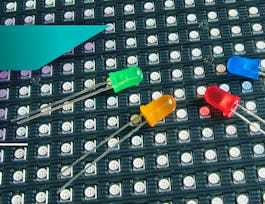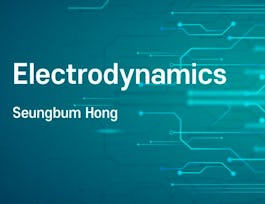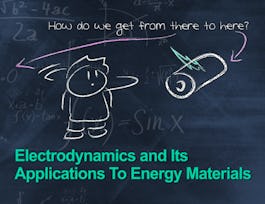This course gives you access to basic tools and concepts to understand research articles and books on modern quantum optics. You will learn about quantization of light, formalism to describe quantum states of light without any classical analogue, and observables allowing one to demonstrate typical quantum properties of these states. These tools will be applied to the emblematic case of a one-photon wave packet, which behaves both as a particle and a wave. Wave-particle duality is a great quantum mystery in the words of Richard Feynman. You will be able to fully appreciate real experiments demonstrating wave-particle duality for a single photon, and applications to quantum technologies based on single photon sources, which are now commercially available. The tools presented in this course will be widely used in our second quantum optics course, which will present more advanced topics such as entanglement, interaction of quantized light with matter, squeezed light, etc...



Quantum Optics 1 : Single Photons


Instructors: Alain Aspect
Sponsored by IEM UEM Group
27,636 already enrolled
(323 reviews)
Skills you'll gain
Details to know

Add to your LinkedIn profile
26 assignments
See how employees at top companies are mastering in-demand skills


Earn a career certificate
Add this credential to your LinkedIn profile, resume, or CV
Share it on social media and in your performance review

There are 7 modules in this course
In this first lesson, you will discover what is canonical quantization, apply it to the quantization of a single mode of the electromagnetic field, and find that it behaves as a quantum harmonic oscillator. The notion of photon will then naturally emerge, as well as the weird but fundamental notion of vacuum fluctuations.
What's included
13 videos3 readings10 assignments
In this lesson, you will discover how the quantum optics formalism leads to the particle-like behaviour of a one photon wave-packet. For this, you will have to learn the quantum optics expressions of the simple and joint photodetection signals. A comparison with the semi-classical expressions will illustrate the necessity of quantum optics.
What's included
7 videos2 readings5 assignments
In this lesson, you will address the fascinating question of a single photon interfering with itself, by calculating the interference pattern for a single photon launched into a Mach-Zehnder interferometer. In order to do it you will first learn how to treat a beam-splitter in quantum optics, a very important tool that you need to know. You will also learn that when you want to describe an optical instrument in quantum optics, it is very useful to master its classical optics description. This lesson is an opportunity to think about the mysterious concept of wave-particle duality, and about the power of the quantum formalism, which can deal consistently with two behaviours apparently contradictory .
What's included
6 videos3 readings4 assignments
In the real world there is nothing like purely monochromatic radiation. A correct description of radiation necessarily involves several modes. In this lesson, you will learn how canonical quantization can be easily generalized to the case of several modes, and how various observables or important quantities introduced in the single mode case are expressed in the multimode case. Beyond the formalism that you must learn to be able to read papers and books describing real situtations, you will encounter in this lesson some intriguing features of the quantum formalism: firstly, the unbelievably large size of the space of states, which is the reason for the unlimited potential power of quantum information; secondly, the question of infinities, a problem which was solved by the general procedure of renormalization. Note that optional readings are proposed as resources of some lectures.
What's included
8 videos3 readings2 assignments
One photon sources are important components in quantum optics, both in research laboratories and in applied quantum technologies. The lesson of this week will present the various kinds of one-photon sources available today, from heralded one photon sources to one photon sources on demand. You will learn how to use the multimode formalism presented in a previous lesson, to describe one-photon wave packets, in particular in the case of a spontaneously emitted photon. You will start with the presentation of a theoretical tool much used in quantum optics, the Heisenberg formalism. It will allow you to discover the formula expressing the probability of a double detection at two different times. You will also learn some `tricks of the trade' about Fourier transforms.
What's included
7 videos2 readings1 assignment
You are now ready to develop the description of a real experiment , which was the first one to reveal directly the dual nature -- wave and particle, of a real single photon wave-packet. You will not only be able to describe, with the formalism you have learned, both the particle-like and the wave-like behaviors, but you will also see how to take into account the features of a real experiment, which is never perfect. Last and not least, we will have the opportunity to think about the notions of wave-particle duality and complementarity, which should be not confused, and about thethe statement of Feynman, who named wave-particle duality “a great quantum mystery”. I will try to convince you that when one identifies a mysterious behavior, one should not complain, but rather explore the possibility that something new and interesting can emerge from that mystery.
What's included
8 videos2 readings2 assignments
In this lesson, you will discover two quantum technologies based on one photon sources. Quantum technologies allow one to achieve a goal in a way qualitatively different from a classical technology aiming at the same goal. For instance, quantum cryptography is immune to progress in computers power, while many classical cryptography methods can in principle be broken when we have more powerful computers. Similarly, quantum random number generators yield true random numbers, while classical random number generators only produce pseudo-random numbers, which might be guessed by somebody else than the user. This lesson is also an opportunity to learn two important concepts in quantum information: (i) qubits based on photon polarization; (ii) the celebrated no-cloning theorem, at the root of the security of quantum cryptography.
What's included
7 videos1 reading2 assignments
Instructors


Offered by
Why people choose Coursera for their career




Learner reviews
323 reviews
- 5 stars
88.54%
- 4 stars
9.28%
- 3 stars
0.92%
- 2 stars
0.61%
- 1 star
0.61%
Showing 3 of 323
Reviewed on Dec 26, 2017
Very good introduction to the subject, I enjoyed the dynamics of the lessons. I am looking forward for the more advanced part 2!
Reviewed on Jul 2, 2020
One of the best Course that i have attended. Properly designed and standard assignments.
Reviewed on May 9, 2020
beautiful explanation with in depth coursework in quantum optics. one should must study this course
Recommended if you're interested in Physical Science and Engineering

École Polytechnique Fédérale de Lausanne

Korea Advanced Institute of Science and Technology(KAIST)

Korea Advanced Institute of Science and Technology(KAIST)

Open new doors with Coursera Plus
Unlimited access to 10,000+ world-class courses, hands-on projects, and job-ready certificate programs - all included in your subscription
Advance your career with an online degree
Earn a degree from world-class universities - 100% online
Join over 3,400 global companies that choose Coursera for Business
Upskill your employees to excel in the digital economy



